2019 MASERATI GRANTURISMO CONVERTIBLE coolant level
[x] Cancel search: coolant levelPage 17 of 296

WARNING!
California Proposition 65
Operating, servicing and maintaining
a passenger vehicle or off-road vehicle
can expose you to chemicals including
such as, engine exhaust, carbon
monoxide, phthalates and lead, that
which are know to the State of
California to cause cancer and birth
defects or other reproductive harm. To
minimize exposure, avoid breathing
exhaust, do not idle the engine except
as necessary, service your vehicle in a
well-ventilated area and wear gloves
or wash your hands frequently when
servicing your vehicle. For more
information go to:
www.P65Warnings.ca.gov/passenger-
vehicle Warning Symbols Catalytic converter
Do not park the vehicle
over flammable materials.
Refer to chapter “Pollution
Control Devices” in section
"Driving".
Engine - Engine Oil Filler
Cap
Engine oil. We recommend
you use oil with the
characteristics indicated in
chapter “Refillings” in
section “Features and
Specifications”.
Hydraulic steering
reservoir
Power steering fluid. Do
not exceed max. level. We
recommend you use liquid
with the characteristics
indicated in chapter
“Refillings” in section
“Features and
Specifications”. Brake fluid reservoir
Brake fluid type DOT 4. Do
not exceed max. level. We
recommend you use fluid
with the characteristics
indicated in chapter
“Refillings” in section
“Features and
Specifications”.
Radiator coolant expansion
reservoir
Use antifreeze liquid for
radiators with the
characteristics indicated in
chapter “Refillings” in
section “Features and
Specifications”.
Windshield washer fluid
reservoir
Windshield washer. We
recommend you use liquid
with the characteristics
indicated in chapter
“Refillings” in section
“Features and
Specifications”.Introduction
1
13
Page 122 of 296
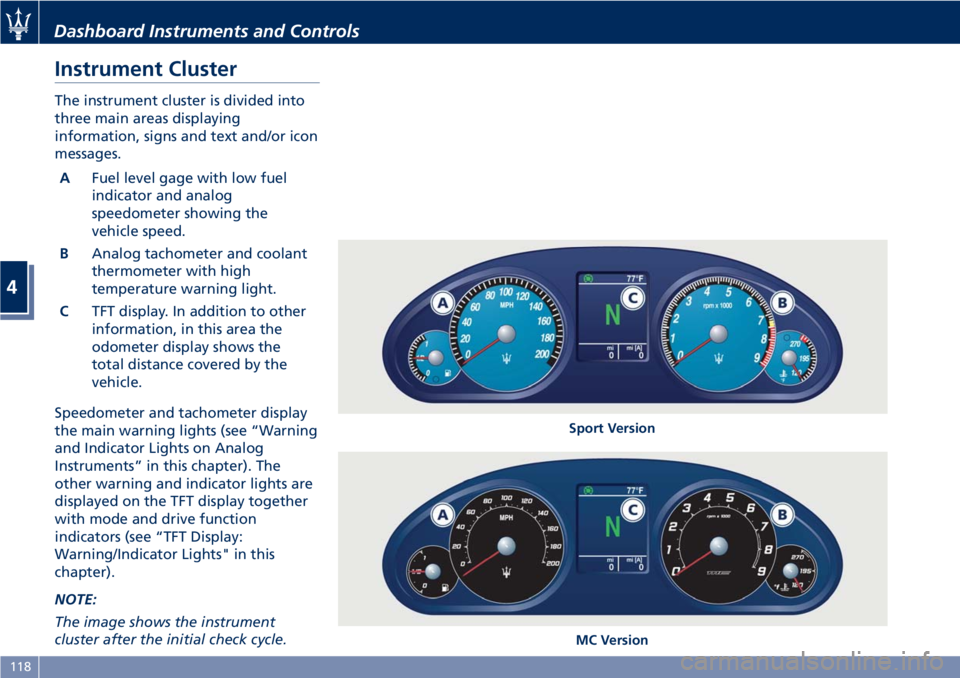
Instrument Cluster The instrument cluster is divided into
three main areas displaying
information, signs and text and/or icon
messages.
A Fuel level gage with low fuel
indicator and analog
speedometer showing the
vehicle speed.
B Analog tachometer and coolant
thermometer with high
temperature warning light.
C TFT display. In addition to other
information, in this area the
odometer display shows the
total distance covered by the
vehicle.
Speedometer and tachometer display
the main warning lights (see “Warning
and Indicator Lights on Analog
Instruments” in this chapter). The
other warning and indicator lights are
displayed on the TFT display together
with mode and drive function
indicators (see “TFT Display:
Warning/Indicator Lights" in this
chapter).
NOTE:
The image shows the instrument
cluster after the initial check cycle. Sport Version
MC VersionDashboard Instruments and Controls
4
118
Page 132 of 296

Engine Temperature Warning Light
This warning light coupled
with the light on the coolant
thermometer notifies when
the engine is overheated. If
the temperature reaches critical levels
this warning light will illuminate in red
color combined with the related
message on display.
If the indicator light switches on while
driving, safely pull over and stop the
vehicle. If the A/C system is on, turn it
off. Also, shift the transmission into N
(Neutral) and idle the vehicle. If the
temperature does not return to
normal, immediately turn the engine
off and contact an Authorized
Maserati Dealer .
Check “Engine Overheating” in section
“In an Emergency” for more
information.
Doors and Lids Open Warning Light
This warning light indicates
that the doors or lids are open
or not properly closed. The
instrument cluster display also
shows an image of the vehicle with the
part not closed highlighted in red and
the related message. WARNING!
Before starting off, close any doors
and lids that are open or not properly
closed.
Soft Top Failure Warning Light
This
warning light illuminates
if the hydraulic and electric
soft top movement systems
fail.
Fuel Cutout Enabled Warning Light
This warning light illuminates
when a collision activates the
inertia switch, thus cutting off
the fuel supply.
WARNING!
After a collision, if you smell fuel or
note leakages from the fuel system,
do not reactivate the switch in order
to prevent the risk of fire.
Windshield and Headlights Washer
Low
Fluid Indicator
This indicator will illuminate
for 10 seconds to indicate a
low level of the windshield
and headlights washer fluid. A
related message will be displayed. See “Maintenance Procedures” in
section “Maintenance and Care” for
fluid filling.
Lighting System Failure Warning Light
This warning light illuminates
in the case of a system failure
or burning-out of the position,
turn signal, rear fog and
license plate light bulbs.
See "Bulb Replacement" in section
"Maintenance and Care" for further
details.
Stop Light Failure Warning Light
This warning light illuminates
in the case of a system failure
or burning-out of the stop
light bulbs.
See "Bulb Replacement" in section
"Maintenance and Care" for further
details.
Twilight Sensor Failure Warning Light
This warning light illuminates
in the case of a failure of the
twilight sensor.
Contact an Authorized
Maserati Dealer to have the vehicle
checked.Dashboard Instruments and Controls
4
128
Page 169 of 296
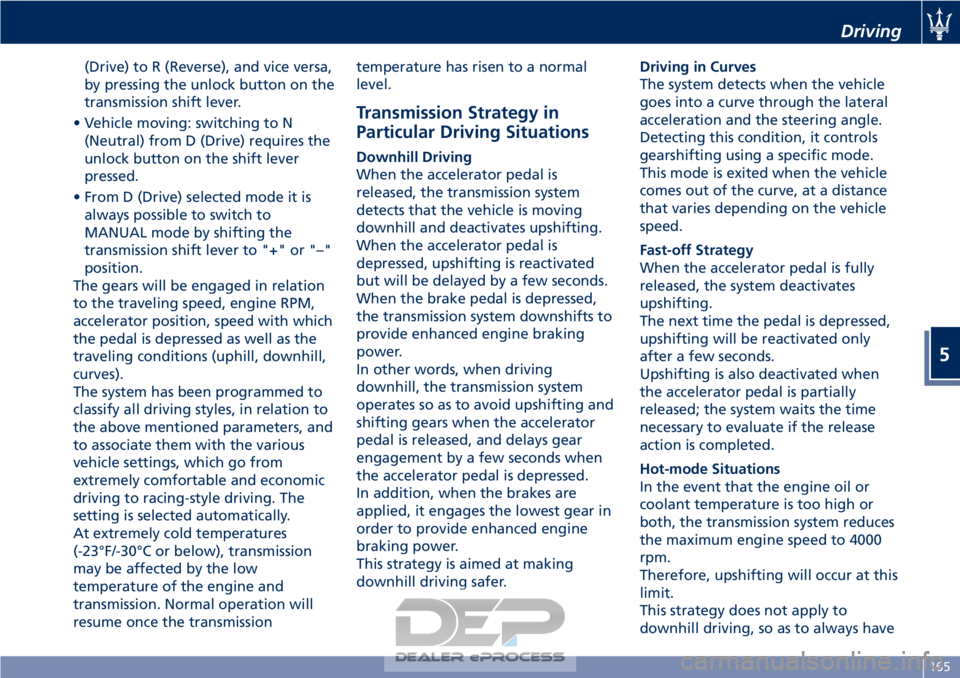
(Drive) to R (Reverse), and vice versa,
by pressing the unlock button on the
transmission shift lever.
• Vehicle moving: switching to N (Neutral) from D (Drive) requires the
unlock button on the shift lever
pressed.
• From D (Drive) selected mode it is always possible to switch to
MANUAL mode by shifting the
transmission shift lever to "+" or "–"
position.
The gears will be engaged in relation
to the traveling speed, engine RPM,
accelerator position, speed with which
the pedal is depressed as well as the
traveling conditions (uphill, downhill,
curves).
The system has been programmed to
classify all driving styles, in relation to
the above mentioned parameters, and
to associate them with the various
vehicle settings, which go from
extremely comfortable and economic
driving to racing-style driving. The
setting is selected automatically.
At extremely cold temperatures
(-23°F/-30°C or below), transmission
may be affected by the low
temperature of the engine and
transmission. Normal operation will
resume once the transmission temperature has risen to a normal
level.
Transmission Strategy in
Particular Driving Situations
Downhill Driving
When the accelerator pedal is
released, the transmission system
detects that the vehicle is moving
downhill and deactivates upshifting.
When the accelerator pedal is
depressed, upshifting is reactivated
but will be delayed by a few seconds.
When the brake pedal is depressed,
the transmission system downshifts to
provide enhanced engine braking
power.
In other words, when driving
downhill, the transmission system
operates so as to avoid upshifting and
shifting gears when the accelerator
pedal is released, and delays gear
engagement by a few seconds when
the accelerator pedal is depressed.
In addition, when the brakes are
applied, it engages the lowest gear in
order to provide enhanced engine
braking power.
This strategy is aimed at making
downhill driving safer.
Driving in Curves
The system detects when the vehicle
goes into a curve through the lateral
acceleration and the steering angle.
Detecting this condition, it controls
gearshifting using a specific mode.
This mode is exited when the vehicle
comes out of the curve, at a distance
that varies depending on the vehicle
speed.
Fast-off Strategy
When the accelerator pedal is fully
released, the system deactivates
upshifting.
The next time the pedal is depressed,
upshifting will be reactivated only
after a few seconds.
Upshifting is also deactivated when
the accelerator pedal is partially
released; the system waits the time
necessary to evaluate if the release
action is completed.
Hot-mode Situations
In the event that the engine oil or
coolant temperature is too high or
both, the transmission system reduces
the maximum engine speed to 4000
rpm.
Therefore, upshifting will occur at this
limit.
This strategy does not apply to
downhill driving, so as to always have
Driving
5
165
Page 239 of 296

Service coupons 1° 2° 3° 4° 5° 6° 7° 8° 9° 10° 11° 12°
Main operations Maintenance schedules: every 12500 mi (20000 km) or 2 years
Air injection system: connections and pipes
valves IIIIIIIIIIII
Blow-by system III II
Fuel emission control system: lines,
connections and valves III III
Automatic transmission oil level IIIIIIIIIIII
Differential oil level IIIIIIIIIIII
Hydraulic steering fluid level (bleed if
necessary) IIIIIIIIIIII
Replace at least every 2 years
Engine coolant level IIIIIIIIIIII
Replace at least every 2 years
Brake fluid level (bleed if necessary) IIIIIIIIIIII
Replace at least every 2 years
Brake system: lines, calipers, connections -
Efficiency of the dashboard warning lights
- Parking brake operation IIIIIIIIIIII
Wear condition of the braking parts
(rotors, pads); replace if necessary IIIIIIIIIIII
Joints for front and rear suspensions, front
and rear under-chassis – Tightening
torques IIIIIIIIIIII
Steering system components, joint
protection, rack trunks on the steering
levers and on the axle shafts IIIIIIIIIIII
Maintenance and Care
7
235
Page 241 of 296
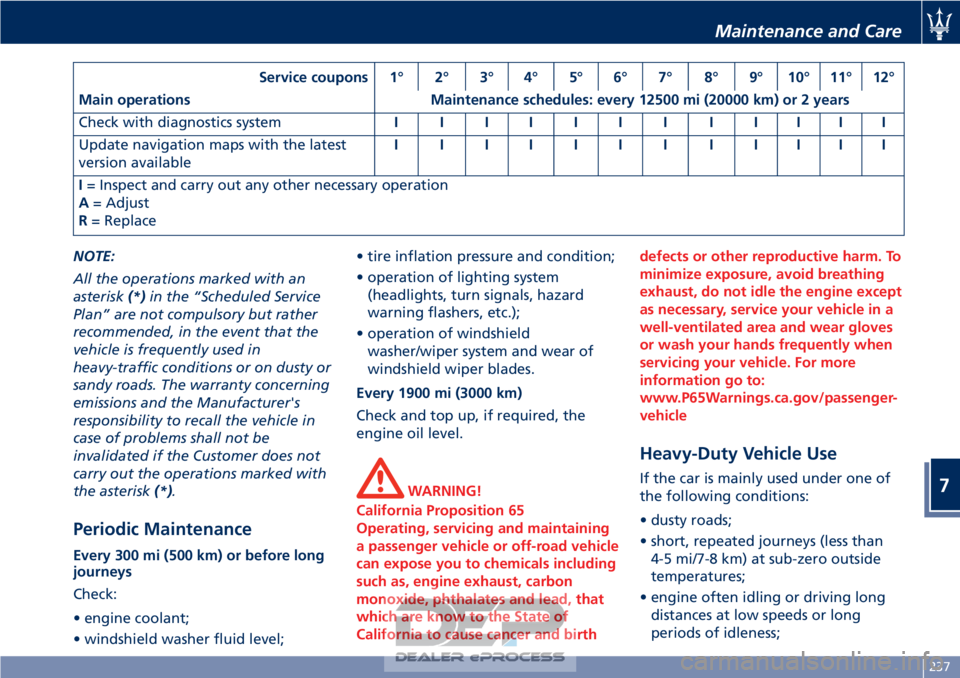
Service coupons 1° 2° 3° 4° 5° 6° 7° 8° 9° 10° 11° 12°
Main operations Maintenance schedules: every 12500 mi (20000 km) or 2 years
Check with diagnostics system IIIIIIIIIIII
Update navigation maps with the latest
version available IIIIIIIIIIII
I = Inspect and carry out any other necessary operation
A = Adjust
R = Replace
NOTE:
All the operations marked with an
asterisk (*)in the “Scheduled Service
Plan” are not compulsory but rather
recommended, in the event that the
vehicle is frequently used in
heavy-traffic conditions or on dusty or
sandy roads. The warranty concerning
emissions and the Manufacturer's
responsibility to recall the vehicle in
case of problems shall not be
invalidated if the Customer does not
carry out the operations marked with
the asterisk (*).
Periodic Maintenance
Every 300 mi (500 km) or before long
journeys
Check:
• engine coolant;
• windshield washer fluid level; • tire inflation pressure and condition;
• operation of lighting system
(headlights, turn signals, hazard
warning flashers, etc.);
• operation of windshield washer/wiper system and wear of
windshield wiper blades.
Every 1900 mi (3000 km)
Check and top up, if required, the
engine oil level.
WARNING!
California Proposition 65
Operating, servicing and maintaining
a passenger vehicle or off-road vehicle
can expose you to chemicals including
such as, engine exhaust, carbon
monoxide, phthalates and lead, that
which are know to the State of
California to cause cancer and birth defects or other reproductive harm. To
minimize exposure, avoid breathing
exhaust, do not idle the engine except
as necessary, service your vehicle in a
well-ventilated area and wear gloves
or wash your hands frequently when
servicing your vehicle. For more
information go to:
www.P65Warnings.ca.gov/passenger-
vehicle
Heavy-Duty Vehicle Use
If the car is mainly used under one of
the following conditions:
• dusty roads;
• short, repeated journeys (less than
4-5 mi/7-8 km) at sub-zero outside
temperatures;
• engine often idling or driving long distances at low speeds or long
periods of idleness;
Maintenance and Care
7
237
Page 244 of 296
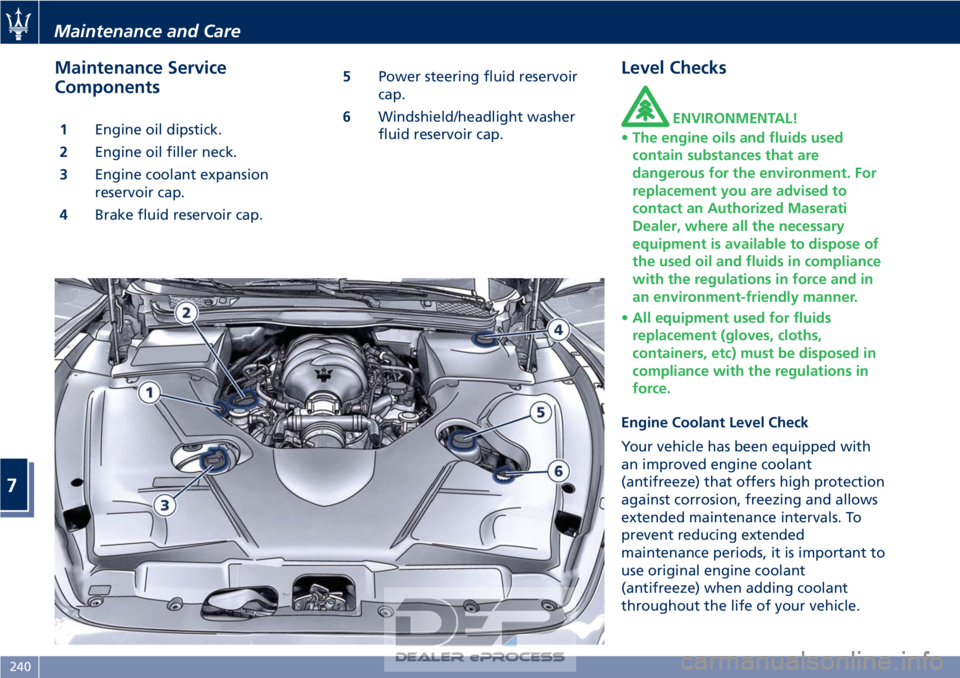
Maintenance Service
Components
1Engine oil dipstick.
2 Engine oil filler neck.
3 Engine coolant expansion
reservoir cap.
4 Brake fluid reservoir cap. 5
Power steering fluid reservoir
cap.
6 Windshield/headlight washer
fluid reservoir cap.
Level Checks
ENVIRONMENTAL!
• The engine oils and fluids used
contain substances that are
dangerous for the environment. For
replacement you are advised to
contact an Authorized Maserati
Dealer, where all the necessary
equipment is available to dispose of
the used oil and fluids in compliance
with the regulations in force and in
an environment-friendly manner.
• All equipment used for fluids
replacement (gloves, cloths,
containers, etc) must be disposed in
compliance with the regulations in
force.
Engine Coolant Level Check
Your vehicle has been equipped with
an improved engine coolant
(antifreeze) that offers high protection
against corrosion, freezing and allows
extended maintenance intervals. To
prevent reducing extended
maintenance periods, it is important to
use original engine coolant
(antifreeze) when adding coolant
throughout the life of your vehicle.
Maintenance and Care
7
240
Page 245 of 296
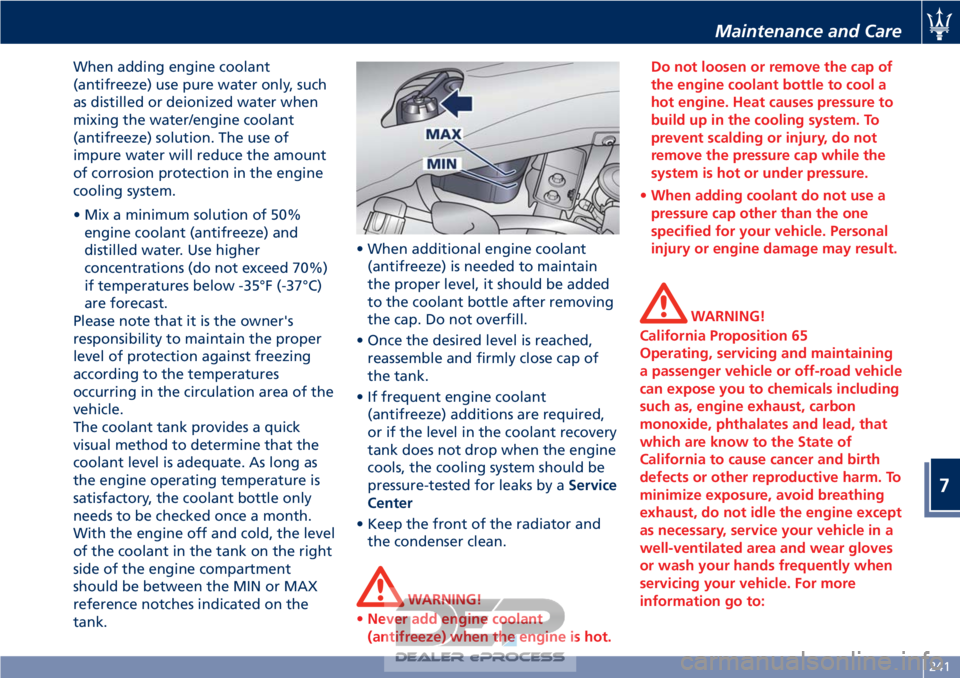
When adding engine coolant
(antifreeze) use pure water only, such
as distilled or deionized water when
mixing the water/engine coolant
(antifreeze) solution. The use of
impure water will reduce the amount
of corrosion protection in the engine
cooling system.
• Mix a minimum solution of 50%engine coolant (antifreeze) and
distilled water. Use higher
concentrations (do not exceed 70%)
if temperatures below -35°F (-37°C)
are forecast.
Please note that it is the owner's
responsibility to maintain the proper
level of protection against freezing
according to the temperatures
occurring in the circulation area of the
vehicle.
The coolant tank provides a quick
visual method to determine that the
coolant level is adequate. As long as
the engine operating temperature is
satisfactory, the coolant bottle only
needs to be checked once a month.
With the engine off and cold, the level
of the coolant in the tank on the right
side of the engine compartment
should be between the MIN or MAX
reference notches indicated on the
tank. • When additional engine coolant
(antifreeze) is needed to maintain
the proper level, it should be added
to the coolant bottle after removing
the cap. Do not overfill.
• Once the desired level is reached, reassemble and firmly close cap of
the tank.
• If frequent engine coolant (antifreeze) additions are required,
or if the level in the coolant recovery
tank does not drop when the engine
cools, the cooling system should be
pressure-tested for leaks by a Service
Center
• Keep the front of the radiator and the condenser clean.
WARNING!
• Never add engine coolant
(antifreeze) when the engine is hot. Do not loosen or remove the cap of
the engine coolant bottle to cool a
hot engine. Heat causes pressure to
build up in the cooling system. To
prevent scalding or injury, do not
remove the pressure cap while the
system is hot or under pressure.
• When adding coolant do not use a
pressure cap other than the one
specified for your vehicle. Personal
injury or engine damage may result.
WARNING!
California Proposition 65
Operating, servicing and maintaining
a passenger vehicle or off-road vehicle
can expose you to chemicals including
such as, engine exhaust, carbon
monoxide, phthalates and lead, that
which are know to the State of
California to cause cancer and birth
defects or other reproductive harm. To
minimize exposure, avoid breathing
exhaust, do not idle the engine except
as necessary, service your vehicle in a
well-ventilated area and wear gloves
or wash your hands frequently when
servicing your vehicle. For more
information go to:
Maintenance and Care
7
241